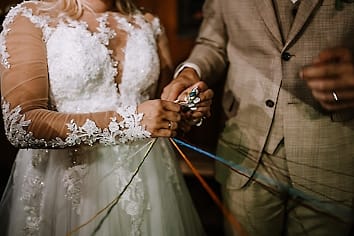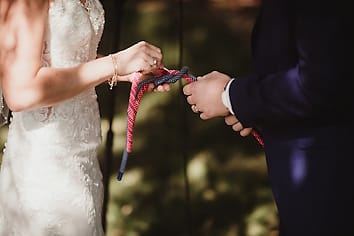
Unity rituals are a popular way to add an extra layer of symbolism and meaning to any wedding ceremony. Some couples choose to mix together two types of sand into one glass container, while others will take a shot of their favorite drink together. However, the unity ritual that is most well known (and has the longest history) is the handfasting ceremony.
Handfasting is the ancient practice of binding a couple’s hands ceremonially, usually with a rope or cord. Ever wonder where the phrase “tying the knot” originates from? You guessed it – handfasting!
While this is most often included in Wiccan and pagan weddings, in recent years handfasting has become more mainstream and is commonly incorporated in weddings for other faith traditions, as well as secular nuptials. Handfasting is also not limited to weddings – the symbolism lends itself nicely to vow renewals, commitment ceremonies, and more!
So, what is the history of handfasting? What does the ceremony symbolize? And how do you actually perform one? This page will cover everything you need to know about handfasting.
What Is the History of Handfasting?
Historically speaking, handfasting refers to a kind of union originating from the British Isles (most likely with the Celts) as far back as 7000 B.C. Unlike many traditions, handfasting usually did not involve an officiant, though this is not really the case today as most locations do not allow for self-solemnization.
In historical contexts, handfasting was sometimes used to signify a betrothal or a temporary marriage agreement that could last for a year and a day, after which the couple could decide to enter into a permanent marriage or part ways without consequences. Over time, the binding became a central part of the marriage ceremony itself.
Today, handfasting is often incorporated into modern wedding ceremonies, especially among those who appreciate its historical significance or seek to include a visual and symbolic representation of their union. It's particularly popular in neopagan ceremonies, such as those within Wicca and other earth-based spiritualities.
Handfasting is a traditional ceremony that symbolically binds a couple together in marriage or partnership to represent their commitment. The act of binding hands in a handfasting ceremony carries deep symbolism, reflecting various aspects of the couple’s commitment and the nature of their relationship. Some of the primary symbolic elements include:
- Unity and Connection: The primary symbol represented by the binding of hands is that of unity. The cords or ribbons, often colorful and made of different materials, represent the coming together of two separate lives intertwined to form a single, unified existence. Just as the cords are tied, so too are the lives and destinies of the couple tied together.
- Eternity and Continuity: The loop or the knot that forms during the binding is often seen as a symbol of eternity. It represents a continuous, unbroken circle, much like the wedding ring, symbolizing everlasting love and commitment that is meant to continue throughout the couple's lives.
- Strength and Support: The binding also symbolizes strength and support. The cords represent the strength that the couple gains from each other. Bound together, they are stronger than they are individually, suggesting that their union will provide mutual support and resilience against challenges.
- Sacrifice and Compromise: The act of having one's hands bound can also symbolize the sacrifices and compromises that are necessary in a committed relationship. It signifies a willingness to be bound to the agreements, responsibilities, and challenges that come with marriage.
What Do You Need for a Handfasting?
-
1. Handfasting Ceremony Script
Although theoretically you could wrap a couple’s hands without saying anything and then move on, this would both be quite unconventional and probably come off as rushed. When performing a handfasting, you’ll need a script! The officiant will typically introduce the ceremony, talk about its meaning, and then include a blessing or speech while binding the couple’s hands. If you’re curious to see what an example handfasting script looks like, please review our sample handfasting ceremony script.
-
2. Handfasting Cord
In order to perform a ritual binding, you’ll need something to bind with. Cords, ropes, or ribbons are the most commonly used materials for this, but any material that is comfortable and easy to untie afterward will do. To add an extra flourish, you might consider using some of the following in your binding:
- Natural garland
- Vines
- Shells
- Beads
- The couple's engagement rings
- Heirloom charms or rings
- Family birthstones
- Woven flowers
If you are braiding your own cord or cutting a strand of existing material, the binding should be a little over one yard in length so that it can be wrapped around the couple’s hands multiple times.
You may also choose to purchase a pre-made binding to make sure you have the correct length and that the ceremony will go smoothly. If so, keep in mind that we offer a ceremonial handfasting cord in our online catalog.
-
3. Handfasting Certificate
Lastly, most officiants like to have a handfasting certificate on hand to present to the couple following the ceremony. Whether for a wedding, vow renewal, or some other type of commitment ceremony, a signed certificate is a wonderful keepsake for couples to take home to commemorate the occasion.
How to Perform a Handfasting

With those materials gathered, you’re ready to perform the handfasting! The distinguishing feature of the service is, naturally, the linking of the couple’s hands. This can be done by simply clasping the right hand of one partner to the right hand of the other, and vice versa while they face each other.
The crossing of hands symbolizes the joining of all aspects of the couple; left and right, solar and lunar, masculine and feminine. The figure eight shape also stands for the unending commitment to one another.
Traditionally, the officiating minister would wrap the binding in a figure-eight pattern around the couple’s clasped hands either 3, 6, or 9 times. If more than one person is wrapping the materials, one figure eight per person is probably best.
For the full effect, couples can remain clasped and tied together until the reception (for safety concerns, we do not recommend remaining bound any longer than that, even if that was the ancient practice).
If you brush up on your knowledge of infinity knots, it’s possible that when the couple slips their arms out from the cord, a literal knot will tighten together and remain in the middle. For a detailed explanation of how to tie an infinity knot, check out the video below. It’s also perfectly fine to just remove the hands and undo the binding.
Is Handfasting a Legal Marriage?
No, a handfasting is a symbolic ceremony and does not constitute a legal marriage on its own. In order for a wedding ceremony to be considered legally binding, you must be sure to include a few key legal elements in the script. So long as those are included in addition to the handfasting, and they’re conducted by a minister who was ordained online the wedding will be considered legal! It’s a simple distinction, but an important one.
Today it is perfectly common to see handfasting incorporated as part of ceremonies both pagan and non-pagan alike, and in interesting ways. If a couple has already been legally married, they might want to try a handfasting ceremony as part of their renewal of vows service, or even as part of a wedding anniversary celebration.
What Does a Modern Handfasting Look Like?
Handfasting is an ancient ceremony that has evolved over time. Naturally, some couples want to personalize and modernize it to make the ritual their own.
One modern twist on handfasting involves a fresh take on a parent giving away their child at the altar. In this variation, a couple would have a family member(s) fasten the cord around their clasped hands rather than the officiant.
Conversely, this is also a great way for couples to include their children as part of the ceremony – each one making a figure eight with the same binding, or perhaps each with their own binding of a different material.
How ULC Ministers Approach Handfasting
As members of an interfaith organization, ULC ministers are frequently called upon to preside over handfasting ceremonies and incorporate the ritual into a plethora of wedding styles. Being ordained ministers, ULC members are qualified not only to perform handfastings – they also have the power to pronounce a couple legally married as part of the ceremony. Not yet a ULC minister? You can become ordained in just a few clicks by filling out an ordination application here.

